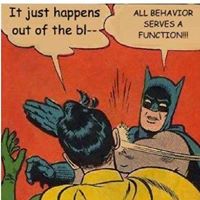Photo source: www.scholastic.com, www.pinterest.com
Most people don't have any idea how materials heavy ABA therapy can be. Added to that is the fact that not every provider supplies their own materials. Some companies will charge the parents to use their materials, and some will not. It is typical that if the company provides materials, then they don't belong to the parents. Meaning whenever services end, those materials have to be returned or the cost must be reimbursed.
This information will be helpful to supervisors too, because it can be a bit overwhelming to get organized when you first start supervising cases. There's just so much to do. I'm happy to help streamline the process a bit.
Please do not take this post as a absolute list of MUST HAVES. These are suggestions, based on what I usually use and how I like to set up my cases/my organizational style. Feel free to modify as needed. :-)
The "Materials Closet"-
During intake I will usually ask the family where in the home therapy could take place, and where program materials can be stored. Then we work together to pick an ideal location. You want a location that doesn't get heavy foot traffic if possible, and that's out of the reach of the little ones. Usually a closet fits that criteria, especially if you add shelves or cabinets that can be locked. Or, you can add a lock to the closet door and just keep the closet locked. Reinforcers should always be kept out of reach, or the staff can bring their own reinforcers with them to sessions. I like to keep the materials closet neat and organized, which is a responsibility all staff should share. At the end of each session all supplies and materials need to be put back inside the closet, in their appropriate folder/bag/drawer. I suggest labeling everything, color coding is nice, and checking over the materials regularly to make sure things aren't broken, stored incorrectly, or missing.
As an example, here is what I usually place in the materials closet: program binders, flashcards (active and maintenance), extra pens/pencils/post it notes/paper/crayons/markers, etc., timers, clipboards, writing paper and construction paper, blank data sheets, various small manipulatives (can be used for matching, sorting, sequencing patterns, etc), academic workbooks, picture books, 3 hole punch, and materials for particular programs. For example, if we are teaching Puzzles then inside the closet we would have at least 2 peg puzzles, inset puzzles, and possibly jigsaw puzzles.
Organizational Tools-
I love all of these.
Staff Resources-
In the front of my program binders I like to include training resources. These are usually general documents that explain Pairing, Preference Assessments, how to complete data sheets, etc. You can also choose to keep a file folder of resources with the program materials, for example the token board or a behavioral visual aid that is only used as needed. If you have the room, it can also be helpful to store some books or articles that staff can refer to during sessions (e.g. the Cooper book). On a recent case I kept resources on feeding interventions with the program materials, so staff could refer back to it as needed. If there are parent training goals, I also like to have a separate parent training binder. In the front of that binder, I will include resources/handouts for the parents.
Spend time, not $$-
As much as possible I like to make my own materials. Once a target is mastered that flashcard may never be seen again, or only when running maintenance. Google images is my friend :-) Type what you need into Google (e.g. cat), select images, and then print the one you want. I suggest always printing at least 2 different images so you can teach generalization (print a brown cat, and a white cat). For sight words, letter identification, number identification, etc., don't you dare buy flashcards! Get some index cards and a black Sharpie, and make them yourself. Also, fancy toys break or get destroyed during a rough session. So go to your local thrift store and stock up on used toys and books. Another tip: laminate everything. You will thank me after the client tries to chew on all the flashcards. Who will be spending time making all of this stuff will depend on the case...sometimes the parents help make materials for my cases, sometimes I assign the Lead therapist to do it, and sometimes I do it.

















No comments